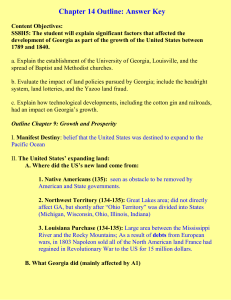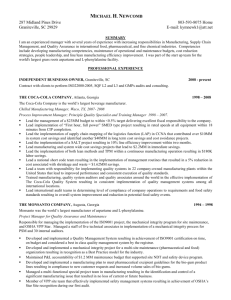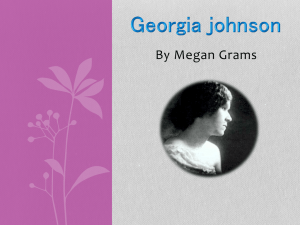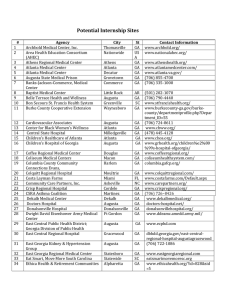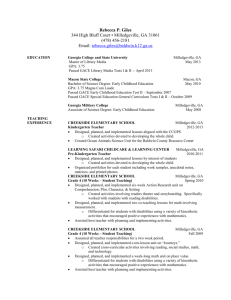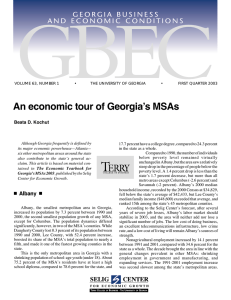Growth of Georgia 1790-1840
advertisement
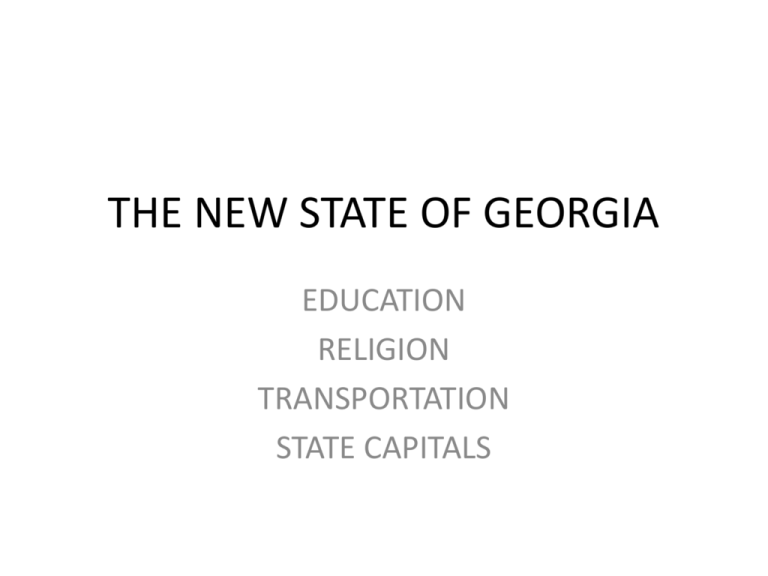
THE NEW STATE OF GEORGIA EDUCATION RELIGION TRANSPORTATION STATE CAPITALS Growth of Georgia • 1789-New Constitution 3 branches of government General Assembly still had the most power • Georgia large in land size but small in population • Need for new settlers for the frontier area • Westward expansion • 1790-1840- population quadrupled RELIGION • Religion strongly influenced growth in the new state • Second Great Awakening (1790-1830)- an increased interest in religion • Growth of Protestant religion • Gained the nickname “Bible Belt” Baptist Different groups: Southern, Primitive, Free Will • GA Baptist Convention- joined different Baptists • Created Southern Baptist Convention (largest Protestant group today) METHODIST RELIGION • • • • Tent Revivals Camp meetings: outside, informal Helped Methodist church grow 1803- first tent revival/camp meeting held in Hancock County • Created foundation for importance of religion ANGLICAN • Extension of the Church of England • Biggest group after the Revolution • Changed to the Episcopalian Church EDUCATION AND UGA • • • • • • • • Abraham Baldwin- founder and 1st president CHARTER 1785 633 acres- donated by John Milledge First public university in USA First called Franklin College 1st school open to the lower classes Felt education was needed for a free gov’t 1801- held first classes, Women- 1918 • http://link.brightcove.com/services/player/bcpid1017290000 1?bctid=17697198001 (Abraham Baldwin BIO GA Stories) Technology Better Transportation New machines to help with agriculture Invention of the cotton gin 1793 • Eli Whitney • Separated the seed from the cotton fiber • Twice as fast as a person doing by hand • Plantation owners needed more people to help grow and pick the crop TRANSPORTATION • Colonial period- walk, horse, wagon • Move to unsettled areas and new towns, need to connect these regions and towns. • Steam boat/rivers (coastal plain) • Good transportation needed for growth in the interior of state • Canals- to connect rivers, waterways (north mostly)- ex: Erie Canal • GA- plan for 4 canals- Altamaha to Brunswick • Started, but abandoned for RAILROAD RAILROADS • 1833 State chartered two railroads, Georgia Railroad Company and Central Georgia Railroad • 1837-Western & Atlantic RR (W&A) • Placed stake 7 m E of Chattahoochee River and called the location “Terminus” • By 1860- all but 2 RR lines passed through this city • Terminus became known as Marthasville, then Atlanta Georgia’s Capital City • • • • • S- SAVANNAH A- AUGUSTA L- LOUISVILLE M- MILLEDGEVILLE A- ATLANTA CHANGING CAPITALS • Louisville in 1796-1807 • Changed from Augusta • William Few helped decide where it would change to. • Near Ogeechee River • Named for King Louis XVI for support during the Rev War • Did well at first- tobacco • 1807 then to Milledgeville CITY DATE CAPITAL FACT REASON FOR MOVING Savannah 1733 Georgia’s first capital Georgia’s population was in the area around Augusta Augusta 1786 Alternate capital during the American Revolution Location was too far east; a more central location was needed Louisville 1796 Site where Yazoo Act was repealed and burned on the capitol grounds Moved to follow population growth in the west Milledgeville 1807 Land lotteries conducted here; capital during the Civil War Georgia voters chose Atlanta as the capital after the Civil War Atlanta 1868 The capitol building was built for less than $1 million Atlanta is Georgia’s capital city today. HISTORY OF GEORGIA CAPITALS 1777-78 Savannah 1779-80 Augusta* 1780-81 Washington, miscellaneous sites in Wilkes County* 1781-82 Augusta 1782 Ebenezer*, Savannah 1783 Augusta 1784 Savannah, Augusta 1785 Savannah 1786-96 Augusta 1796-1806 Louisville 1807-1868 Milledgeville 1868-present Atlanta * Temporary meeting sites of state government


